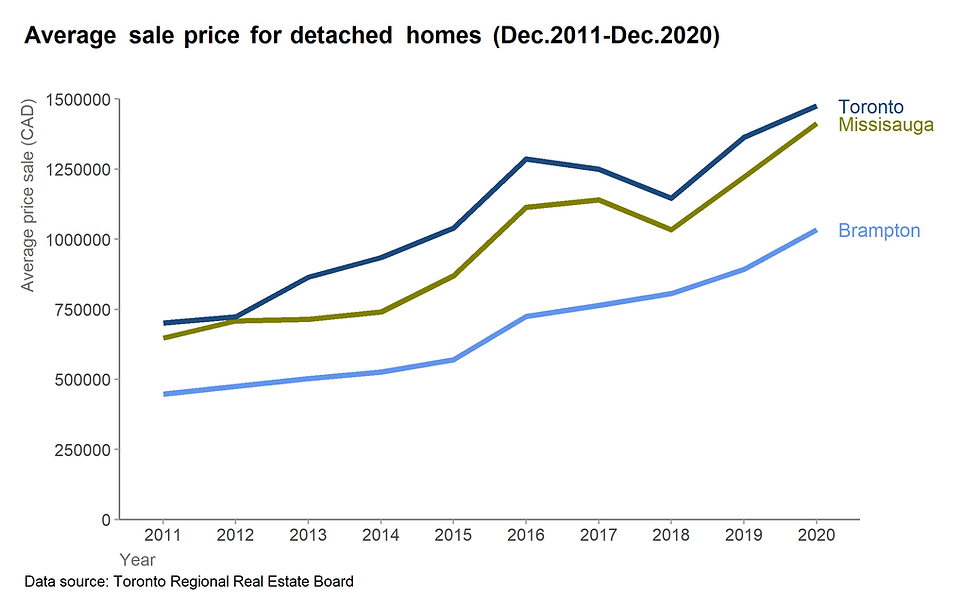Visualizing Amounts: Dot plots and their derivatives
- sam33frodon
- Jan 18, 2021
- 2 min read
One of the simplest visualizations of a single numerical variable with a modest number of observations and labels for the observations is a dot plot, or Cleveland dot plot.
In this post, we will use the gapminder data set (which is avaibale in package gapminder) The gapminder dataset is well explored in the statistic course by Professor Jennt Bryan, The University of British Columbia (https://stat545.com/)
library(tidyverse)
library(ggplot2)
library(gapminder)gapminder %>%
filter(year == 2007, continent == "Americas") %>%
select(country, lifeExp,pop) %>%
ggplot() +
geom_point(aes(x = lifeExp,
y = reorder(country,lifeExp)),
color = "blue",
size = 5) +
labs(x = "Life Expectancy (years)", y = NULL) +
theme(text = element_text(size = 16),
panel.border = element_rect(fill = NA, colour = "grey20")) +
labs(title = "Life expectancy in Americas (2007)",
x = "Life expectancy (years)",
y = NULL) +
theme_minimal()
In order to highlight the best
gapminder %>%
filter(year == 2007, continent == "Americas") %>%
select(country, lifeExp,pop) %>%
mutate(condition = if_else(lifeExp >= 75, ">=75","<75")) %>%
mutate(highlight = factor(condition)) %>%
ggplot(aes(x = lifeExp,
y = reorder(country,lifeExp),
color = highlight)) +
geom_point(size = 5) +
scale_color_manual(values=c("red", "blue")) +
labs(x = 'Life expectency (years)',
y = NULL,
title = "The top 10 causes of death in 2016") +
theme(axis.text = element_text(size = 14, color = "black"),
axis.title = element_text(size = 14, color = "black",face="bold"),
plot.title = element_text(color = "black", size = 14, face = "bold"),
plot.caption = element_text(color = "black",size = 14, face = "italic"),
legend.position = "none")
The size of the dots can be used to encode an additional numeric variable. This view uses area to encode population size (This is sometimes called a bubble chart)
gapminder %>%
filter(year == 2007, continent == "Americas") %>%
select(country, lifeExp,pop) %>%
ggplot() +
geom_point(aes(y = reorder(country, lifeExp),
x = lifeExp,
size = pop/1000000),
col = "blue") +
labs(x = "Life Expectancy (years)", y = NULL) +
scale_size_area("Population\n(Millions)", max_size = 8) +
theme(text = element_text(size = 16),
panel.border = element_rect(fill = NA, colour = "grey20")) +
theme_minimal()
We can also compare data.
Example: Compare the data for 2002 and 2007 for the Americas
gapminder %>%
filter(year >= 2002, continent == "Americas") %>%
mutate(Year = factor(year)) %>%
ggplot() +
geom_point(aes(y = reorder(country, lifeExp),
x = lifeExp,
size = 2,
color = Year)) +
scale_color_manual(values=c("#E69F00", "#56B4E9")) +
labs(x = "Life Expectancy (years)", y = NULL) +
theme(text = element_text(size = 16),
panel.border = element_rect(fill = NA, colour = "grey20")) +
theme_minimal()
All countries show some improvement in life expectancy. The small improvement for Jamaica.
All countries show some improvement in life expectancy. The small improvement for Jamaica.
gapminder %>%
filter(year >= 2002, continent == "Americas") %>%
mutate(Year = factor(year)) %>%
ggplot(aes(y = reorder(country, lifeExp),
x = lifeExp)) +
geom_line(aes(group = country),
size = 1.5,
color = "grey") +
geom_point(aes(color = Year),
size = 4) +
scale_color_manual(values=c("red", "blue")) +
labs(x = "Life Expectancy (years)", y = NULL) +
theme(text = element_text(size = 16),
panel.border = element_rect(fill = NA, colour = "grey20")) +
theme_minimal()









Comments